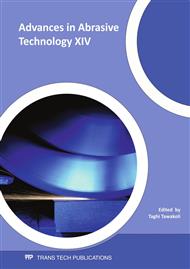p.678
p.684
p.693
p.699
p.707
p.713
p.719
p.725
p.731
Implementation of Glass Transition Physics in Glass Molding Simulation
Abstract:
Glass transition is the most important factor in the thermo-forming of glass elements of precise geometries such as optical glass lenses. Among many attempts to model the physics of glass transition, the Master equations based on the potential energy landscape (PEL) appear to be apropos. In this study, we used Monte-Carlo approach to approximately solve the master equations and further implement the Monte-Carlo method in the finite element simulation. We used Selenium as an example since its PEL has been quantified. Through the FEM simulations, it is found that the geometrical replication quality is the best when the forming is performed at the viscosity around 105~106 Pa×s, that the residual stress developed in the cooling process can be minimized in the slow cooling process or through post-annealing process after moulding.
Info:
Periodical:
Pages:
707-712
Citation:
Online since:
August 2011
Authors:
Price:
Сopyright:
© 2011 Trans Tech Publications Ltd. All Rights Reserved
Share:
Citation:


